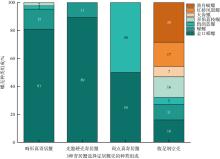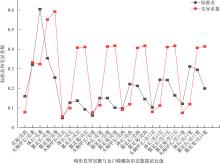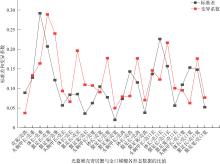| [1] |
贾男, 周天成, 胡思敏, 等, 2024. 南沙群岛海域珊瑚礁区三种寄居蟹的摄食差异比较[J]. 热带海洋学报, 43(3): 109-121.
|
|
JIA NAN, ZHOU TIANCHENG, HU SIMIN, et al, 2024. Difference in the feeding contents of three hermit crabs in coral reefs of Nansha Island, South China Sea[J]. Journal of Tropical Oceanography, 43(3): 109-121 (in Chinese with English abstract).
|
| [2] |
荆圆圆, 胡凡光, 刘广斌, 等, 2023. 山东沿海不同地理群体中国蛤蜊形态差异分析[J]. 海洋渔业, 45(1): 95-104.
|
|
JING YUANYUAN, HU FANGUANG, LIU GUANGBIN, et al, 2023. Morphological variation analysis of different geographical populations of Mactra chinensis[J]. Marine Fisheries, 45(1): 95-104 (in Chinese with English abstract).
|
| [3] |
王旭, 徐衡, 邹莉, 等, 2013. 3个单齿螺地理群体形态差异分析[J]. 南方水产科学, 9(4): 22-27.
|
|
WANG XU, XU HENG, ZOU LI, et al, 2013. Morphological variation analysis of three differente geographic populations of Monodonta labio[J]. South China Fisheries Science, 9(4): 22-27 (in Chinese with English abstract).
|
| [4] |
张素萍, 2008. 中国海洋贝类图鉴[M]. 北京: 海洋出版社: 40.
|
|
ZHANG SUPING, 2008. Atlas of marine mollusks in China[M]. Beijing: China Ocean Press: 40 (in Chinese).
|
| [5] |
周天成, 2020. 三亚鹿回头近岸珊瑚礁区寄居蟹的摄食及生态功能探讨[D]. 北京: 中国科学院大学: 1-18.
|
|
ZHOU TIANCHENG, 2020. Feeding and ecological function of hermit crabs in Luhuitou coastal coral reefs in Sanya[D]. Beijing: University of Chinese Academy of Sciences: 1-18 (in Chinese with English abstract).
|
| [6] |
ANGEL J E, 2000. Effects of shell fit on the biology of the hermit crab Pagurus longicarpus (Say)[J]. Journal of Experimental Marine Biology and Ecology, 243(2): 169-184.
|
| [7] |
APPRILL A, 2020. The role of symbioses in the adaptation and stress responses of marine organisms[J]. Annual Review of Marine Science, 12: 291-314.
doi: 10.1146/annurev-marine-010419-010641
pmid: 31283425
|
| [8] |
ARCE E, ALCARAZ G, 2012. Shell preference in a hermit crab: comparison between a matrix of paired comparisons and a multiple-alternative experiment[J]. Marine Biology, 159(4): 853-862.
|
| [9] |
BARNES D K A, 1999. Ecology of tropical hermit crabs at Quirimba Island, Mozambique: shell characteristics and utilisation[J]. Marine Ecology Progress Series, 183: 241-251.
|
| [10] |
BENVENUTO C, GHERARDI F, 2001. Population structure and shell use in the hermit crab, Clibanarius erythropus: a comparison between Mediterranean and Atlantic shores[J]. Journal of the Marine Biological Association of the United Kingdom, 81(1): 77-84.
|
| [11] |
CAVANAUGH C M, 1994. Microbial symbiosis: patterns of diversity in the marine environment[J]. American Zoologist, 34(1): 79-89.
|
| [12] |
CONOVER M R, 1978. The importance of various shell characteristics to the shell-selection behavior of hermit crabs[J]. Journal of Experimental Marine Biology and Ecology, 32(2): 131-142.
|
| [13] |
CRUMP A, MULLENS C, BETHELL E J, et al, 2020. Microplastics disrupt hermit crab shell selection[J]. Biology Letters, 16(4): 20200030.
|
| [14] |
ELWOOD R W, 2018. Hermit crabs-information gathering by the hermit crab, Pagurus bernhardus[M]// BUENO-GUERRA N, AMICI F. Field and laboratory methods in animal cognition: A comparative guide. Cambridge: Cambridge University Press: 222-243.
|
| [15] |
FOTHERINGHAM N, 1976. Population consequences of shell utilization by hermit crabs[J]. Ecology, 57(3): 570-578.
|
| [16] |
GILCHRIST S L, 2003. Hermit crab population ecology on a shallow coral reef (Bailey’s Cay, Roatan, Honduras): octopus predation and hermit crab shell use[J]. Memoirs of Museum Victoria, 60(1): 35-44.
|
| [17] |
GORMAN D, RAGAGNIN M N, MCCARTHY I D, et al, 2018. Risk-taking and risk-avoiding behaviors by hermit crabs across multiple environmental contexts[J]. Journal of Experimental Marine Biology and Ecology, 506: 25-29.
|
| [18] |
GUTIÉRREZ J L, JONES C G, STRAYER D L, et al, 2003. Mollusks as ecosystem engineers: the role of shell production in aquatic habitats[J]. Oikos, 101(1): 79-90.
|
| [19] |
HAHN D R, 1998. Hermit crab shell use patterns: response to previous shell experience and to water flow[J]. Journal of Experimental Marine Biology and Ecology, 228(1): 35-51.
|
| [20] |
HALPERN B S, 2004. Habitat bottlenecks in stage-structured species: hermit crabs as a model system[J]. Marine Ecology Progress Series, 276: 197-207.
|
| [21] |
HAZLETT B A, 1970. Tactile stimuli in the social behavior of Pagurus bernhardus (Decapoda, Paguridae)[J]. Behaviour, 36(1-2): 20-48.
|
| [22] |
JONES C G, LAWTON J H, SHACHAK M, 1997. Positive and negative effects of organisms as physical ecosystem engineers[J]. Ecology, 78(7): 1946-1957.
|
| [23] |
LAIDRE M E, 2011. Ecological relations between hermit crabs and their shell-supplying gastropods: constrained consumers[J]. Journal of Experimental Marine Biology and Ecology, 397(1): 65-70.
|
| [24] |
LANCASTER I, 1990. Reproduction and life history strategy of the hermit crab Pagurus bernhardus[J]. Journal of the Marine Biological Association of the United Kingdom, 70(1): 129-142.
|
| [25] |
LEE Y K, LEE J H, LEE H K, 2001. Microbial symbiosis in marine sponges[J]. Journal of Microbiology, 39(4): 254-264.
|
| [26] |
MANTELATTO F L, DE LUCCA MEIRELES A, 2004. The importance of shell occupation and shell availability in the hermit crab Pagurus brevidactylus (Stimpson, 1859) (Paguridae) population from the southern Atlantic[J]. Bulletin of Marine Science, 75(1): 27-35.
|
| [27] |
MITCHELL K A, 1976. Shell selection in the hermit crab Pagurus bernhardus[J]. Marine Biology, 35(4): 335-343.
|
| [28] |
REESE E S, 1963. The behavioral mechanisms underlying shell selection by hermit crabs[J]. Behaviour, 21(1-2): 78-124.
|
| [29] |
RIMMER J E V, TODD C D, SHUKER D M, 2021. Context-dependent use of visual cues in the shell selection behaviour of the hermit crab Pagurus bernhardus[J]. Behavioural Processes, 188: 104414.
|
| [30] |
ROUX N, LAMI R, SALIS P, et al, 2019. Sea anemone and clownfish microbiota diversity and variation during the initial steps of symbiosis[J]. Scientific Reports, 9(1): 19491.
doi: 10.1038/s41598-019-55756-w
pmid: 31862916
|
| [31] |
TOMATSURI M, KON K, 2017. Effects of dead oyster shells as a habitat for the benthic faunal community along rocky shore regions[J]. Hydrobiologia, 790(1): 225-232.
|
| [32] |
VANCE R R, 1972. Competition and mechanism of coexistence in three sympatric of intertidal hermit crabs[J]. Ecology, 53(6): 1062-1074.
|
| [33] |
VÖLKER L, 1967. Zur gehäusewahl des land-einsiedlerkrebses Coenobita scaevola Forskal vom roten meer[J]. Journal of Experimental Marine Biology and Ecology, 1(2): 168-190.
|
| [34] |
WALLENTINUS I, NYBERG C D, 2007. Introduced marine organisms as habitat modifiers[J]. Marine Pollution Bulletin, 55(7-9): 323-332.
pmid: 17207503
|
| [35] |
WILLIAMS J D, MCDERMOTT J J, 2004. Hermit crab biocoenoses: a worldwide review of the diversity and natural history of hermit crab associates[J]. Journal of Experimental Marine Biology and Ecology, 305(1): 1-128.
|
| [36] |
WIRTZ P, 1997. Crustacean symbionts of the sea anemone Telmatactis cricoides at Madeira and the Canary Islands[J]. Journal of Zoology, 242(4): 799-811.
|
| [37] |
YOSHINO K, GOSHIMA S, NAKAO S, 2002. Temporal reproductive patterns within a breeding season of the hermit crab Pagurus filholi: effects of crab size and shell species[J]. Marine Biology, 141(6): 1069-1075.
|
 ), CHEN Zhi1,2, LI Youming1,2, YE Le1,2(
), CHEN Zhi1,2, LI Youming1,2, YE Le1,2( )
)











